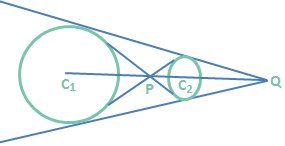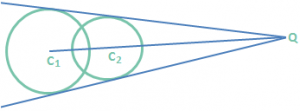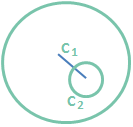Direct Common Tangents: The direct common tangents to two circles meet on the line of centers and divide it externally in the ratio of the radii.
The transverse common tangents also meet on the line of centers and divide it internally in the ratio of the radii
Now we discuss the number of common tangents that exist for the cases specified in the section.
Case (1): Each of the given pair of circles lies in the exterior of the other i.e. C₁C₂ > r₁ + r₂.
r₁ ≠ r₂ (r₁, r₂ are radii of the circles) that R divides C₁C₂ in the ratio r₁ : r₂ internally and Q divides \(\overline{{{C}_{1}}{{C}_{2}}}\) in the same ratio externally. Also note that C₁C₂ > r₁ + r₂. In this case the number of distinct common tangents is 4. \(\overline{{{C}_{1}}{{C}_{2}}}\) > r₁ + r₂ and r₁ = r₂. In this case the direct common tangents are parallel.
\(\overline{{{C}_{1}}{{C}_{2}}}\) > r₁ + r₂ and r₁ = r₂. In this case the direct common tangents are parallel. To find the equations of parallel common tangents, suppose the tangents equation as y = mx + c. The slope m = slope of C₁C₂ from this fact the value of m is known \({{r}_{1}}=\frac{\left| m\left( -{{g}_{1}} \right)-{{f}_{1}}+c \right|}{\sqrt{{{l}^{2}}+{{m}^{2}}}}\) (Radius is equal to perpendicular distance)
To find the equations of parallel common tangents, suppose the tangents equation as y = mx + c. The slope m = slope of C₁C₂ from this fact the value of m is known \({{r}_{1}}=\frac{\left| m\left( -{{g}_{1}} \right)-{{f}_{1}}+c \right|}{\sqrt{{{l}^{2}}+{{m}^{2}}}}\) (Radius is equal to perpendicular distance)
Using the above equation we can find C. In this case the number of common tangents is 4.
Case (2): \(\overline{{{C}_{1}}{{C}_{2}}}\) = r₁ + r₂
Given circles touch each other externally.  In this case the internal centre of similitude P is the point of contact of two given circles. At P there is only one common tangent. Through Q, there will be two common tangents. In this case the number of common tangents is 3.
In this case the internal centre of similitude P is the point of contact of two given circles. At P there is only one common tangent. Through Q, there will be two common tangents. In this case the number of common tangents is 3.
Case (3): |r₁ – r₂| < \(\overline{{{C}_{1}}{{C}_{2}}}\) < r₁ + r₂
given circles intersecting each other In this case the internal centre of similitude does not exist. Only two common tangents through Q can be drawn.
In this case the internal centre of similitude does not exist. Only two common tangents through Q can be drawn.
Case (4): C₁C₂ = |r₁ – r₂|
(i.e., given circles touch each other internally) In this case internal centre of similitude does not exist. Only one common tangent exists at Q.Thus the number of common tangents in the present case is one.
In this case internal centre of similitude does not exist. Only one common tangent exists at Q.Thus the number of common tangents in the present case is one.
Case (5): \(\overline{{{C}_{1}}{{C}_{2}}}\) < |r₁ – r₂|
(i.e., one circle lies entirely in the interior of the other circle)
